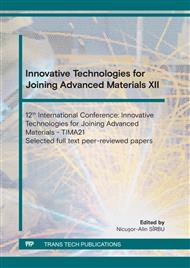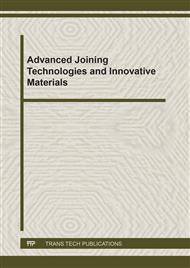[1]
I. Anton, Cavitația, Vol II, Editura Academiei RSR, Bucuresti, (1985).
Google Scholar
[2]
R.Garcia, F.G. Hammitt, R.E. Nystrom, Corelation of cavitation damage with other material and fluid properties, Erosion by Cavitation or Impingement, ASTM, STP 408 Atlantic City, (1960).
DOI: 10.1520/stp46052s
Google Scholar
[3]
I. Bordeaşu, Eroziunea cavitaţională a materialelor, Editura Politehnica, Timişoara, (2006).
Google Scholar
[4]
I. Lazar, Tehnici de optimizare a rezistenţei la eroziune prin cavitaţie a unor aliaje Cu-Zn şi Cu-Sn, Teza de doctorat, Timisoara, (2020).
Google Scholar
[5]
I. Bordeasu, M.O. Popoviciu, C. Ghera, L.M. Micu, L.D. Pirvulescu, T. Bena, The use of Rz roughness parameter for evaluation of materials behavior to cavitation erosion, ICAS 2017, IOP Conference Series: Materials Science and Engineering, Vol. 294, No. 1, art. no. 012020, 2018,.
DOI: 10.1088/1757-899x/294/1/012020
Google Scholar
[6]
I. Bordeasu, Monografia Laboratorului de cercetare a eroziunii prin cavitație al Universității Politehnica Timișoara (1960-2020), Editura Politehnica, Timişoara, (2020).
Google Scholar
[7]
*** https://copperalliance.ro/despre-cupru/cupru-si-aliaje-de-cupru/aliaje//.
Google Scholar
[8]
*** Registrul naval roman, Reguli pentru clasificarea si constructia navelor maritime, Vol V, Bucuresti, (1986).
Google Scholar
[9]
D.C. Stroita, M. Barglazan, A.S. Manea, V.Balasoiu, Double-flux water turbine dynamics, Annals of DAAAM for 2008 and 19th International DAAAM Symposium Intelligent Manufacturing and Automation: Focus on Next Generation of Intelligent Systems and Solutions,, Trnava, 22 October 2008 - 25 October 2008, pp.1325-1326.
Google Scholar
[10]
D.C. Stroita, A.S. Manea, A. Cernescu, Blade polymeric material study of a cross-flow water turbine runner, Materiale Plastice, Volume 56, Issue 2, , 2019, p.366 – 369.
DOI: 10.37358/mp.19.2.5187
Google Scholar
[11]
M. Bǎrglǎzan, C. Velescu, T. Miloş, A. Manea, E. Dobândǎ, C. Stroiţǎ, Hydrodynamic transmission operating with two-phase flow, WIT Transactions on Engineering Sciences, 4th International Conference on Computational and Experimental Methods in Multiphase and Complex Flow, Bologna, 12 - 14 June 2007, Volume 56, Pages 369 – 378, 2007, pp.369-378.
DOI: 10.2495/mpf070361
Google Scholar
[12]
D. Tokar, C. Stroita, A. Tokar, A. Rusen, Hybrid System that Integrates the Lost Energy Recovery on the Water-Water Heat Pump Exhaust Circuit, IOP Conference Series: Materials Science and Engineering, 4th World Multidisciplinary Civil Engineering-Architecture-Urban Planning Symposium, WMCAUS 2019, Prague, 17 - 21 June 2019, Volume 603, Issue 418 September 2019, Article number 042002.
DOI: 10.1088/1757-899x/603/4/042002
Google Scholar



